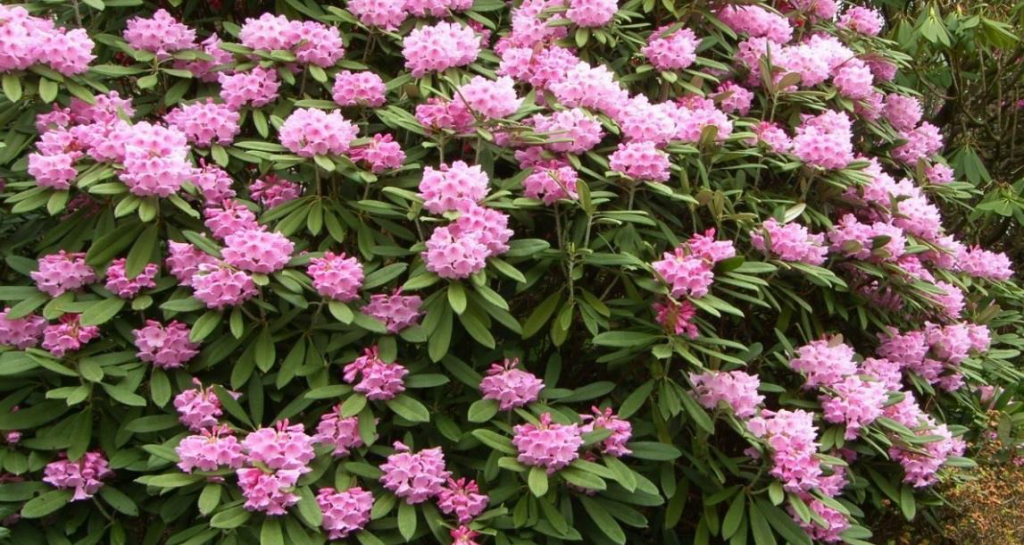
It may seem a bit harsh, to call a green leafy plant that gives lovely large purple flowers in spring a thug, but I am afraid that is what it is.
Volunteers are working to eradicate Rhododendron Ponticum, R. Ponticum, from the woodland. This article explains the reasons why and how you could help as a volunteer.
R. Ponticum is not native to Scotland, or even the UK. Its homeland is in Turkey. It was brought to these shores by Victorian garden and shooting enthusiasts, cross-bred with Rhododendron species from North America and has since spread, and in many areas, spread out of control.
R. Ponticum has managed to spread so successfully because it has a number of tricks up its sleeve. Firstly its flowers can produce an enormous quantity of seeds that are easily spread on the wind to establish new plants over a wide area. Then there is the extensive dense foliage that spreads quickly, blocking out the light to any other plants that manage to seed underneath them giving native species little chance to flourish. Another trick is that any branches that rest on the ground will root and form a new plant, in effect allowing the plant to leap-frog across the ground.
Those lovely lush leaves of the R. Ponticum. contain toxins called Grayanotoxins, which are toxic to a lot of wildlife including most insects. When they are cast off by the plant, they are toxic to the soil. In addition the nitrogen in the leaves is locked up in a way that only R. Ponticum can utilise.
There is some evidence that the mycorrhizas associated with R. Ponticum (the network of soil fungi that provides nutrients to plants), actively suppresses the mycorrhizas of other plants, including trees, in its vicinity. R. Ponticum is a plant hell bent on domination.
R. Ponticum can be a reservoir for diseases deadly to trees including Phythophthora ramorum, which has sadly been found in the woodland resulting in a the felling of a large proportion of the Larch in the forest.
But then there are the lovely purple flowers, surely they can’t cause any harm. I am afraid they are as much a thug as the rest of the plant. The nectar is poisonous to insects including honey bees. If bees survive and make honey, the honey is poisonous and is called ‘Mad Honey’. It was used in historic times in Asia Minor (aka Turkey) to stupefy unsuspecting invading armies. Ancient chemical warfare. Presumably bees in that part of the world have adapted to the toxins. There are plans for bee hives to be established in the walled garden. R. Ponticum will have to be cleared from a large radius around the garden first.
Part of CCDT’s woodland plan is to eradicate the Thug of the Woodland, R. ponticum, though it is a battle that will take some time. It entails cutting and burning the foliage and thin stems. The woody part of the plant, while it does contain grayanotoxins it is at very low concentrations. This material is being stacked and left to rot over time. Eventually the roots will have to be removed or drilled and a Scottish Forestry approved herbicide injected, or else the shrub will simply re-sprout and resume dominance.
It is hoped that following clearing, a more natural and biodiverse understorey can develop with young trees and shrubs that have more ecological value, and hopefully a ground layer of woodland plant species like bluebell and celandine, though this is a long-term ambition.
There are other varieties of rhododendron in the woodland that have some magnificent flowers, mainly in and around the old gardens of Polmaise Castle. These would have been planted as part of the landscaping. While these will share some of the characteristics of R. Ponticum (poisonous leaves and flowers) they appear not to have the same aggression in the woodland. The aim is to retain and manage these rhododendron as part of the regeneration of the gardens.
The work to eradicate R. Ponticum is being carried out only by volunteers. If you would like to help eradicate the Thug of the Woodland, please sign up to be a volunteer. Information on what is involved in being a volunteer can be found on our Volunteering page.
Information for this article was gleaned from a number of sources, most notably:
- Scottish Forestry – Guidance for delivering invasive non-native plant control projects.
- Kew Gardens – article – Hidden poisons in rhododendron nectar
